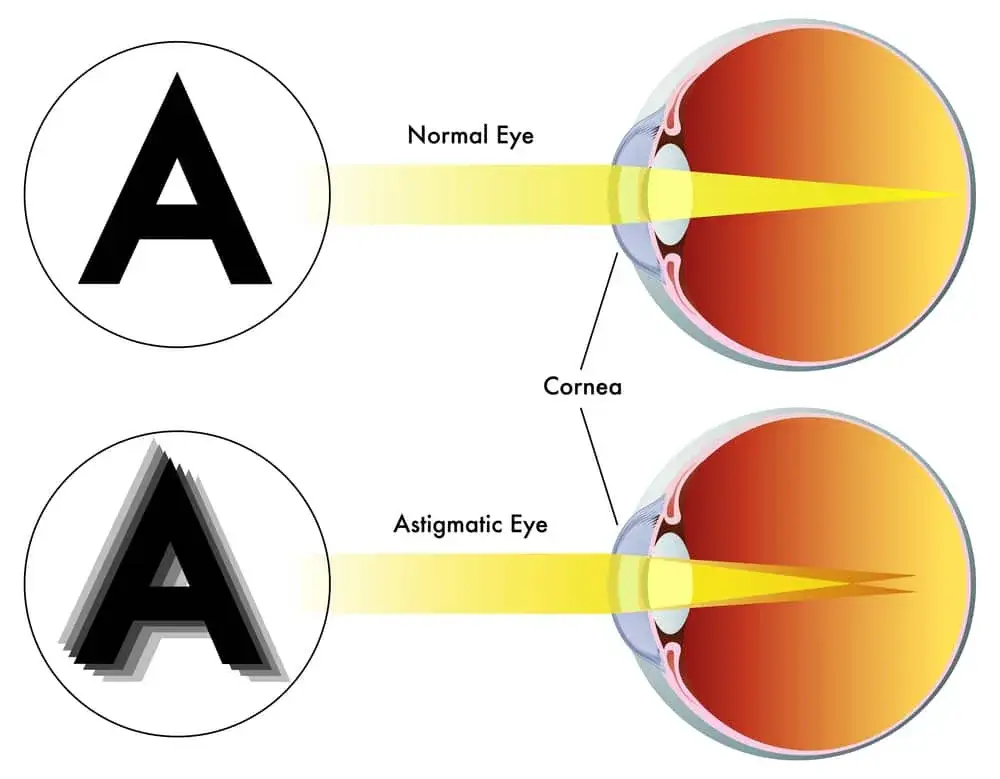Sometimes the front surface of the eye (known as the cornea) or the lens inside the eye are not perfectly round. Instead of having a smooth curve like a ball, they may be shaped more like an egg or a football. This condition is common and treatable, and it’s known as astigmatism. How does this imperfect curvature affect your vision? What are the symptoms of astigmatism? Scroll down to learn more.
Astigmatism 101
When the curve of your cornea or lens is not perfectly round, your vision will be blurred at all distances. Why? Due to the curvature, the light rays entering your eyes won’t be able to refract (i.e., bend) properly.
In some cases, astigmatism is not significant enough to require treatment. Fortunately, however, if you do require treatment for astigmatism, a special set of corrective lenses is often all that’s needed. Sometimes surgery is recommended as well.
The Symptoms of Astigmatism
Although the key symptom of astigmatism is blurry vision, this can lead to other symptoms as well. Signs of astigmatism include all of the following:
- Blurry vision
- Distorted vision
- Eye strain or discomfort
- Headaches
- Difficulty with night vision
- Squinting to try to see clearly
The only way to know if you suffer from astigmatism is to visit an eye doctor and have your eyes checked. If you experience any of the symptoms above and they impact your ability to perform everyday tasks or your enjoyment of life, schedule an appointment when an eye care professional. They can determine whether you have astigmatism, assess the severity of your astigmatism, and offer advice regarding treatment. With their help, you can correct the issue and enjoy clear vision!
Keep in mind that children often aren’t aware that their vision is blurry, which is why it’s important that they have their vision tested regularly by a pediatrician, eye doctor, school nurse, or other trained screener.
What Causes Astigmatism?
Doctors don’t know why cornea shape and lens shape vary from person to person. However, they do know that your risk of astigmatism increases if one or both of your parents have it.
In many cases, astigmatism is present at birth. It may also develop after an eye injury, eye disease, or surgery.
Although you may have heard that astigmatism can be caused or worsened by reading in low-light settings, sitting too close to the TV, holding your phone too close to your face, or squinting, this isn’t true.
What Are the Types of Astigmatism?
There are two basic types of astigmatism: horizontal astigmatism (when the eye is wider than it is tall) and vertical astigmatism (when the eye is taller than it is wide). Both types cause blurry vision at both near and far distances.
Astigmatism often occurs alongside other refractive errors, like nearsightness (also known as myopia) and farsightedness (also known as hyperopia).
_____
Are you suffering from any of the symptoms of astigmatism? Contact your eye doctor today.
Are you looking for an optometrist in southwest Missouri? Visit one of our experienced optometrists at Heffington’s. Since 1975, the Heffington family has been assisting the Springfield community with top-quality eye care and affordable eyeglasses and contacts. One of the unique features of our family-owned business is that we manufacture lenses at our own laboratory, giving us total control over the service and pricing, and we’re happy to pass our savings on to you. To learn more about our products and services, please get in touch with us online, send an e-mail to asktheexperts@heffingtons.com, or give us a call at 417-869-3937 (Optiland location) or 417-882-3937 (House of Vision location). We look forward to hearing from you!

